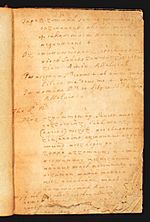Piscataway language facts for kids
Quick facts for kids Piscataway |
|
|---|---|
| Conoy | |
| Native to | United States |
| Region | Maryland |
| Extinct | (date missing) |
| Language family |
Algic
|

The Piscataway language was an Algonquian language. It was once spoken by the Piscataway tribe. This tribe was a powerful group in southern Maryland, near the Chesapeake Bay, when English settlers first arrived.
The Piscataway language is also known as Conoy. This name came from the Iroquois people. Experts believe Piscataway was a dialect of the Nanticoke language. This idea comes from the few old records we have of the language.
The Doeg tribe, who lived in what is now Northern Virginia, might have spoken a similar language. These languages were somewhere between Lenape (spoken to the north in places like Delaware and New Jersey) and Powhatan (spoken to the south in Tidewater Virginia).
What Kind of Language Was Piscataway?
Piscataway is part of a group called Eastern Algonquian languages. These languages were spoken by many Native American tribes along the East Coast of North America.
- Nanticoke-Conoy
- Nanticoke [nnt] (Spoken in the United States)
- Piscataway [psy] (Spoken in the United States)
The History of the Piscataway Language
Sadly, no one speaks Piscataway today. It is an extinct language. However, we still have some old writings that tell us about it.
Many experts believe Piscataway was a dialect of Nanticoke. This is because there are not many old documents for either language. Piscataway was also connected to the Lenape dialects. These were spoken in areas that are now Pennsylvania, Maryland, Delaware, New Jersey, New York, and Connecticut. It was even more closely related to the Powhatan language, which was spoken in Virginia.
The people who first spoke Piscataway lived on the western side of the Chesapeake Bay. This area is now part of Maryland. They lived especially near the lower parts of the Potomac and Patuxent Rivers.
In the early 1600s, a Jesuit missionary named Father Andrew White translated the Catholic catechism into the Piscataway language. Other English teachers also collected words and phrases from the language. The most important record we have is a five-page Catholic instruction written in Piscataway. It is the only full document of the language that still exists today.
How the Piscataway Language Sounded
Even though the Piscataway language is no longer spoken, experts have tried to figure out how it sounded. They have studied the old writings to understand its sounds, called phonemes.
The language had different types of consonant sounds:
- Stops: Sounds like 'p', 't', and 'k'.
- Affricates: A sound like 'ch' (as in 'church').
- Nasals: Sounds like 'm' and 'n'.
- Fricatives: Sounds like 's', 'sh', 'z', 'h', and a sound like 'ch' in Scottish 'loch'.
- Approximants: Sounds like 'w' and 'y'.
It also had several vowel sounds. Some vowels could be short, and some could be long.
- Short vowels: 'i', 'e', 'a', 'o', 'u'.
- Long vowels: 'eː', 'oː', 'uː'. The 'ː' means the vowel sound is held longer.

